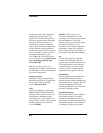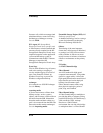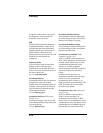
G-11
Glossary
direct backup A SAN-based backup
solution in which data movement
directly from disk to tape (or to other
secondary storage) is facilitated by the
SCSI Extended Copy (Xcopy)
command. Direct backup lessens the
backup I/O load on systems in a SAN
environment. The data movement is
facilitated directly from disk to tape (or
to other secondary storage) by the SCSI
Extended Copy (XCopy) command. The
command is provided by any element of
the infrastructure including bridges,
switches, tape libraries, and disk
subsystems. See also XCopy engine.
directory junction (Windows specific
term)
Directory junctions use the reparse point
concept of Windows. An NTFS 5
directory junction allows you to redirect
a directory/file request to another
location.
Directory Store (DS) (MS Exchange
specific term)
A part of the Microsoft Exchange Server
directory. The Microsoft Exchange
Server directory contains objects used
by Microsoft Exchange applications in
order to find and access services,
mailboxes, recipients, public folders,
and other addressable objects within the
messaging system.
See also Information Store (MDB).
disaster recovery
A process to restore a client’s main
system disk to a state close to the time
when a (full) backup was performed.
Disk Agent
A component needed on a client to back
it up and restore it. The Disk Agent
controls reading from and writing to a
disk. During a backup session, the Disk
Agent reads data from a disk and sends
it to the Media Agent, which then moves
it to the device. During a restore session
the Disk Agent receives data from the
Media Agent and writes it to the disk.
Disk Agent concurrency
The number of Disk Agents that are
allowed to send data to one Media
Agent concurrently.
disk discovery
The detection of disks during client
backup with disk discovery. During this
backup, Data Protector discovers
(detects) the disks that are present on the
client — even though they might not
have been present on the system when
the backup was configured — and backs
them up. This is particularly useful in
dynamic environments, where
configurations change rapidly. After the
disks are expanded, each inherits all
options from its master client object.
Even if pre- and post-exec commands
are specified once, they are started many
times, once per each object.


















